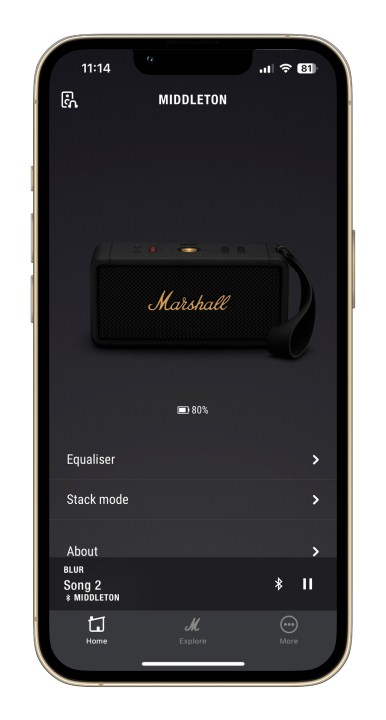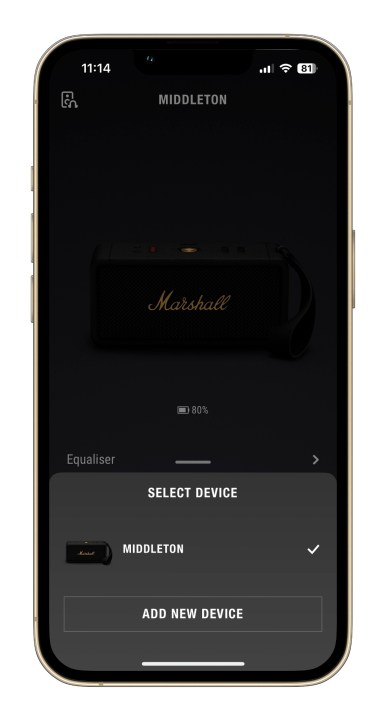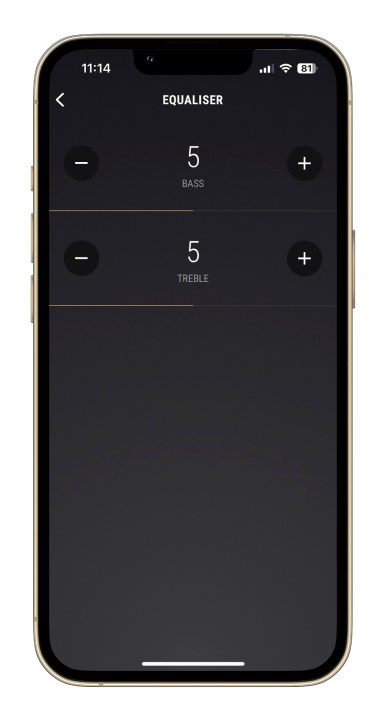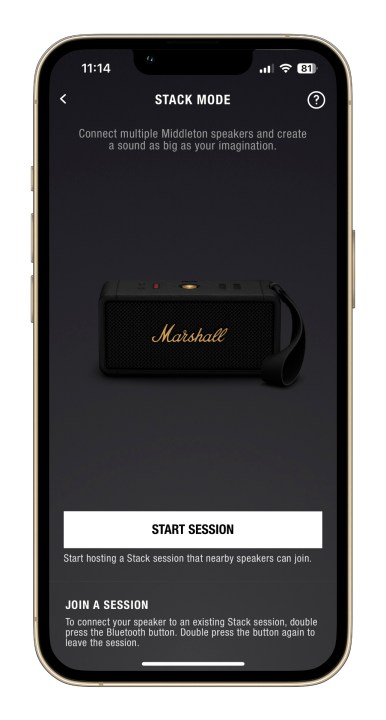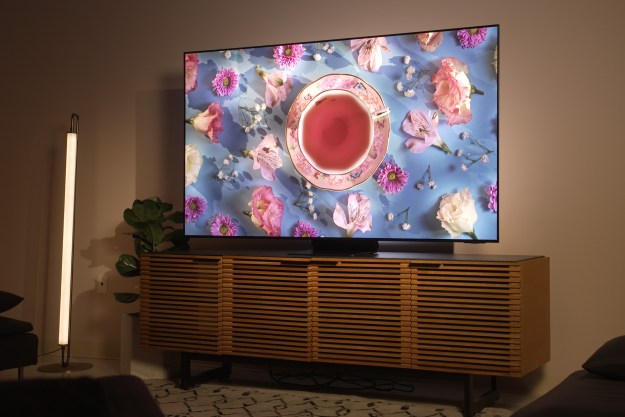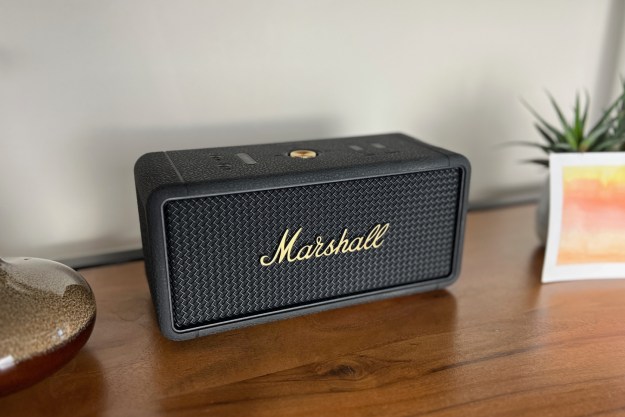
“Marshall's Middleton does its classic guitar amp lineage proud with big, clean sound and rugged portability.”
- Big soundstage for a small package
- Bold bass, clear highs
- IP67 waterproof and dustproof
- AUX input
- Stackable
- Picks up dust and fingerprints easily
- A bit expensive
It’s tough to say if Spinal Tap’s Nigel Tufnel would love the Marshall Middleton Bluetooth speaker. Granted, it doesn’t go to 11. But any fan of Marshall’s legendary guitar amps will immediately feel nostalgic for this speaker’s familiar stylings, right down to the Tolex-like outer texture of the unit, the mesh grille, and the brand’s iconic cursive logo.
You don’t have to be a guitar head to appreciate the sound, though. Marshall for years has successfully moved into the headphone and Bluetooth speaker arena with big and clean-sounding offerings such as our current top pick for the best Bluetooth speaker, the petite , and the even more nostalgic guitar amp-sized Woburn III.
The $300 Middleton, however, sits right in a sweet spot between the two, with a perfect size that’s small enough to take with you, but is packed with four drivers and dual radiators for a huge stereo sound that’s surprisingly room-filling. It’s waterproof, built like a tank, and if it had existed in the ’80s, it would have made those columns of Stonehenge look huge (that’ll be my last Spinal Tap reference, I promise). At any rate, let’s dig into what makes the Marshall Middleton such a great Bluetooth speaker.
Design and features
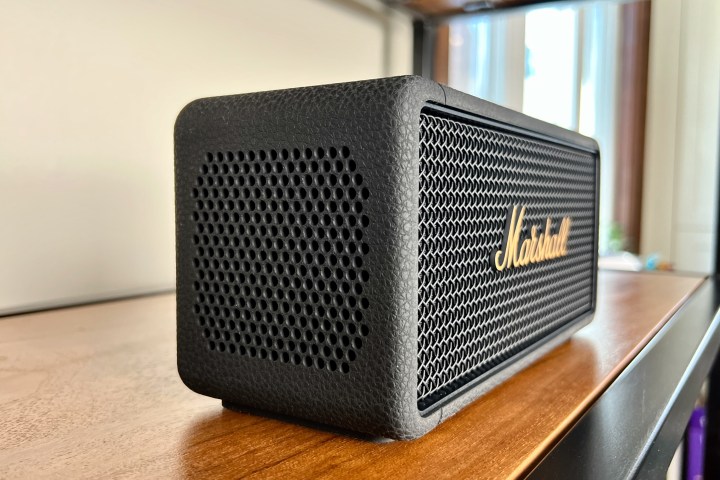
As we mentioned above, if you’re familiar with Marshall’s guitar amps, the Middleton (and any of Marshall’s Bluetooth speakers, for that matter) will make you really nostalgic. And while it might not be subjected to the same sort of beating as a gig-weary Marshall cabinet, the Middleton’s 4.29 x 9.06 x 3.74-inch (109 x 230 x 95 mm) textured silicone cabinet and substantial 4-pound (1.8 kg) weight makes it feel sturdy. It’s hard to believe that it’s meant to be a portable speaker, but with the included rubber strap securely affixed to it, it’s actually pretty mobile for its size.
The Middleton manages to pull off what sounds and feels like a more authentic stereo separation.
The front of the Middleton is covered in a hard plastic mesh and emblazoned with the gold Marshall logo, while the backplate is an even tougher perforated metal. The sides of the Middleton have a similar perforation directly in the cabinet material, which brings us to what’s behind all this protective casing — the drivers.
Drivers
The front grille of the Middleton is a single 0.6-inch tweeter paired with a passive radiator that I discovered handles the right channel of the speaker’s stereo sound, while the same array is repeated on the back to take care of the left channel. Two 3-inch woofers push the low-end out of the left and right sides. The whole system is powered by two 20-watt class D amps for the woofers and two 10-watt class D amps for the tweeters, combining to create what Marshall calls “True Stereophonic” sound, a “unique form of multidirectional stereo sound from Marshall.”
Considering that the vast majority of Bluetooth speakers this size typically use single speakers or are designed with multiple speakers so close together that the stereo effect can often come off as mono, it’s remarkable that the Middleton manages to pull off what sounds and feels like a more authentic stereo separation, even when panning back and forth (more on that later).
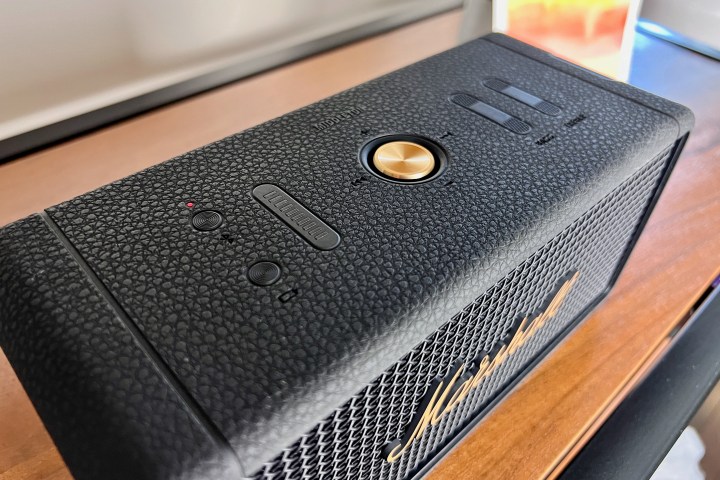
Physical controls
The top of the Middleton is where all the magic happens via its physical controls. It’s adorned with a central gold multifunction button that handles power on/off duties with a long press, as well as volume and previous track/track skip. To the right are dedicated up/down bass and treble controls, which is amazing to see, and on the left there’s an LED battery level indicator that doubles as an indicator for volume, bass, and treble levels when you adjust them. Lastly, to the left of that is a Bluetooth pairing button (which also activates the Stack mode we’ll get into in a second) and a battery level button that, when pressed, lights up the LEDs to show how much charge it has. Oh, and you can also use the Middleton as a power bank to charge up your phone.
Bluetooth connectivity
The Marshall Middleton is a Bluetooth 5.1 speaker that supports the SBC codec, which is a little disappointing — we would have liked to see support for at least AAC at this price, considering you could get yourself a Sonos Roam with AAC and Wi-Fi connectivity for $179, or even a Sony SRS-XG300 that supports hi-res LDAC for under $250. However, if hi-res audio is your main concern, then you probably shouldn’t be looking at the Middleton in the first place. A consolation prize is that the Middleton’s Bluetooth lets you connect up to two devices to it simultaneously so you and a friend can trade off playing DJ.
The Middleton’s rubber carrying strap is firmly connected to the base, making it easy to grab and take to the beach or pool.
Plus, if you really want to access some higher-quality playback on the Middleton, you could use its line-in AUX port on the back and hardwire it to a phone or computer streaming higher-resolution music from a streaming service like Tidal or Apple Music, or music files you might have. You can even connect the Middleton to a turntable via a phono stage (more on this below).
Marshall Bluetooth app
Like a lot more Bluetooth speakers these days, the Middleton also has a companion app (iOS and Android) that works with a range of other Marshall speakers and headphones. With it, you get access to a few other features including app control of the volume, bass, and treble EQ sliders (for those days when you just can’t get up to do it manually), and Marshall’s “Stack” mode, which allows you to connect multiple Middleton speakers together for what I can only imagine is a huge sound (sadly, I was only sent one for this review). The app is pretty easy to use and isn’t bloated with any useless features.
Dustproof and waterproof
And while I preferred the Middleton’s handsome looks safely tucked into a bookshelf in my living room, its IP67 rating and thick, rubber carrying strap that’s firmly connected to the base make it easy to grab and take to the beach or pool without worrying about it taking a dunk. IP67 means it’s dustproof and can be submerged in up to a meter of water for up to 30 minutes. I couldn’t bring myself to tip it over into my hot tub as I did with the more pool party-vibey JBL Pulse 5, but it took every splash like a champ.
Sound quality and performance
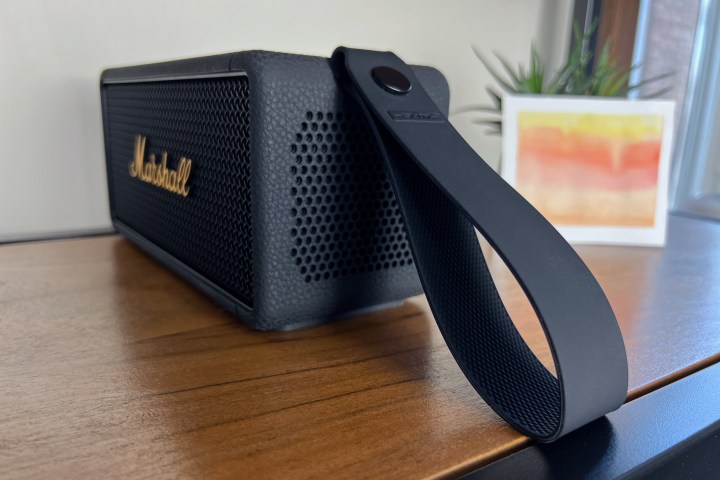
I usually do “in the box” and “setup” sections in these reviews, but it was all so uneventful (that’s a good thing) that I didn’t need to. Pairing with my smartphone or computer is as easy as you’d expect, and in the box all you’ll find is a USB-A to USB-C cable (no power brick, unfortunately), the strap, and a user’s manual.
In the spirit of Bluetooth speaker portability, for my review, I placed the Middleton in several locations — in my small office, on a shelf in my more open dining room area, on my desk facing me, and even outside in the open air. Mainly paired to my iPhone and my MacBook Pro M2 using a mix of Tidal and Spotify, the Middleton’s sound was left at its default 5 bass/5 treble setting, and I didn’t use Spotify’s EQ feature (Tidal doesn’t have any).
The Middleton easily filled my small office with sound, with tight and controlled mids that give distortion guitars crunch and vocals some chest punch.
For my review, I considered listening only to bands that use Marshall amps in their sound, like Led Zeppelin, Jimi Hendrix, Guns N’ Roses, and AC/DC. But as fun as that may seem, I thought that wouldn’t be well-rounded. However, I did start things off by throwing a ton of classic rock at the Middleton, and the thing sounds excellent.
From the opening riff of Whole Lotta Love to Angus Young’s Back in Black solo to Slash’s chirpy-sweet Paradise City intro, it was clear that the Middleton loves guitars. At mid volume, the Middleton easily filled my small office with sound, with tight and controlled mids that give distortion guitars crunch and vocals some chest punch, and high frequencies that added clean definition to instrumentation like cymbals and hi-hats, and the “s” sound in lyrics. It was also nice to be able to pull back on treble if things got a little tinny or add a little (or a lot) of bass to certain types of music, which I could do with the app or on the speaker itself.
Speaking of low-end, this can be the make-or-break area with regard to Bluetooth speakers, but this is where the Middleton surprised me the most. To celebrate the 40th anniversary of New Order’s Blue Monday, I thought it was apt to put the Middleton to the test with its iconic machine-gun kick-drum assault — and give it some volume. The intro punches right in the chest and is tight and controlled, as intended. The Middleton did a great job at handling the round, smooth notes of the bassline and only got a little sloppy at the very top of the volume range, but the overall bass response of the compact speaker sounds beautifully smooth and present.
Whether listening to the Middleton in small rooms, larger spaces or firing right at me on my desk, the speaker has soundstage for days. Moving around the room revealed little nuances in the music that weren’t there in other parts of the room, which can no doubt attributed to the “True Stereophonic” sound firing from all four sides. At volumes higher than 50%, I did find that moving the Middleton away from the wall from four to six inches helped radiate the low-end further out in the space.
Whether listening to the Middleton in small rooms, larger spaces or firing right at me on my desk, the speaker has soundstage for days.
As far as sound sources go, due to the SBC Bluetooth codec, I really couldn’t tell the difference between the Spotify stream and Tidal’s, but they both sounded great through the Middleton. The speaker does have a 3.5mm AUX in port, so I thought I’d check that out, too, connecting my iPhone 13 Pro to it using a Lightning-to-3.4mm adapter. You get a little less volume out of it, but I will say that the direct line added a noticeable amount of clarity and definition from the tracks on my lossless Tidal HiFi account, and the Middleton shined even brighter if you want to be a sound snob about it. But if you really want to get into hi-res lossless music, you should check out Simon Cohen’s review of the Wiim Pro network streamer for a way better way to enjoy digital music.
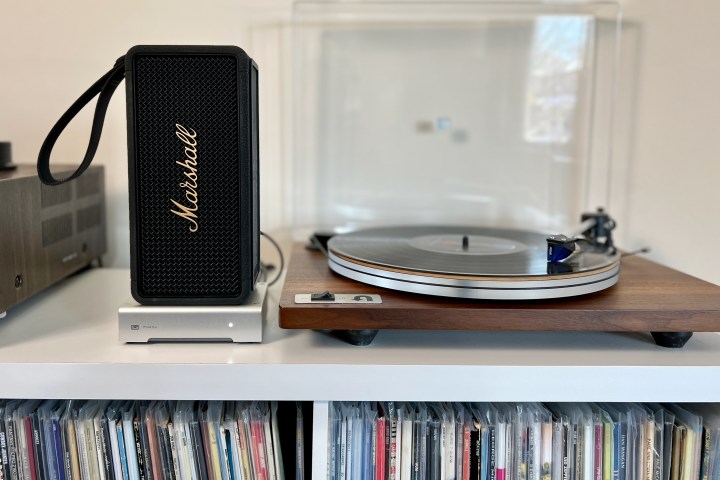
Lastly, as a self-diagnosed vinyl addict, I also connected the Middleton to my turntable using a phono preamp and an RCA-to-3.5mm cable, and … I didn’t hate it. My daughter’s Stranger Things season 4 soundtrack delivered Kate Bush’s Running Up That Hill and Talking Heads’ Psycho Killer to the Middleton, and while I had to ease back on the treble a bit, for the most part, it was balanced. While there’s no way I would make this a permanent setup, I was surprised at how decent this sounded, and it could be a Band-Aid solution for beginners or those in a pinch.
Battery
Like the much smaller Marshall Emberton II, the Middleton can deliver a substantial 20 hours of playback on a charge, which is consistent with my testing. A full charge can be had in around 4.5 hours and, in a pinch, you get two hours of playtime from a quick 20 minutes of charging. Marshall is one of the leaders in battery life and, in comparison, our recently reviewed and similarly- sized JBL Pulse 5 gets just 12 hours, while the Sonos Roam and Sonos Move net around 10 hours each.
Bottom line
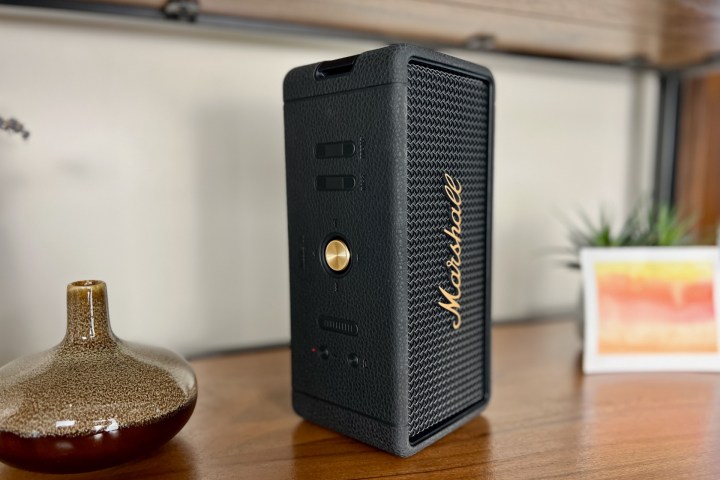
Before the Middleton, I’d never reviewed a Marshall Bluetooth speaker before, and I’m happy to report that it is easily one of the best-sounding I have ever heard, with big, smooth, room-filling sound and a fat low-end with surprising power. Its premium price is reflected in its premium design, but just because it looks fancy (that shiny gold Marshall logo has a lot to do with that) doesn’t mean it’ll shirk its responsibilities as a portable Bluetooth speaker. Its rugged, texturized silicone coating makes it grippy, but even if it does take a tumble, the thing is built like a brick and can take it, even if you drop it in the pool.
I really like how the Middleton looks sleek and sophisticated, even set up in plain sight in my dining room. Some Bluetooth speakers are weird-shaped and adorned with colors and lights that make them an eyesore, but the Middleton is versatile enough to be put anywhere.
For the money, if you were looking to build a bigger whole-home music system, a solution like Sonos might be a better option for its Wi-Fi connectivity and similar, if not cheaper, price point on certain speakers. But for $300, the Marshall Middleton sounds better and louder than the $179 Sonos Roam and can even give the $400 Sonos Move a run for its money, has better battery life, and is more conducive to an on-the-go lifestyle. Plus, with Stack pairing, even though it doesn’t compete with Sonos’ Wi-Fi connectivity, you can expand the system for a bigger sound that even Nigel Tufnel would love.
Editors' Recommendations
- Bluetooth on Sonos’ new Era speakers isn’t what you think – it’s better
- What is Sonos? The speakers, app, and everything you need to know about wireless music
- The first Roku-made televisions are now available at Best Buy
- 11 Sonos tips, tricks, and little-known features
- Sonos’ new Era 100 and Era 300 wireless speakers go all-in on spatial audio and Bluetooth

